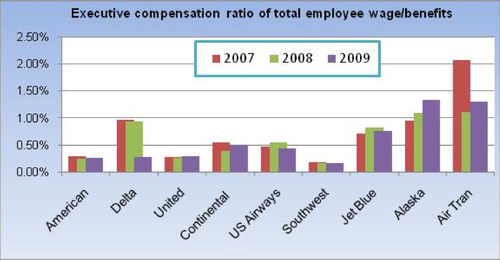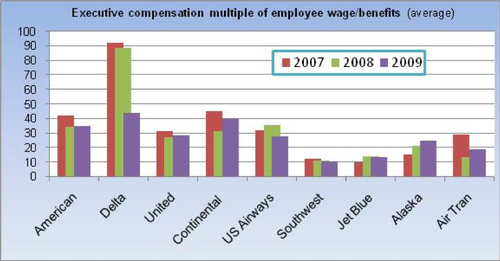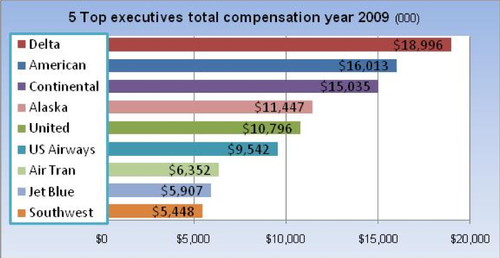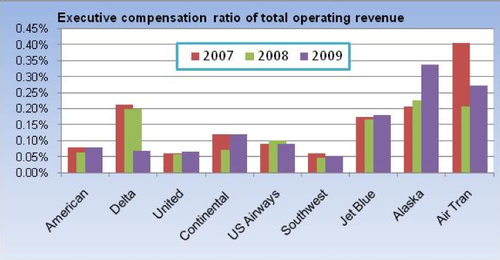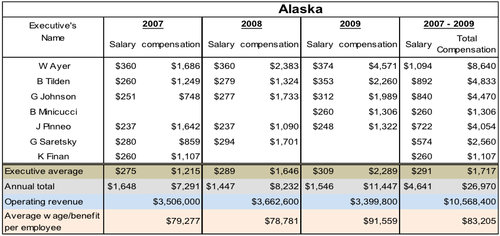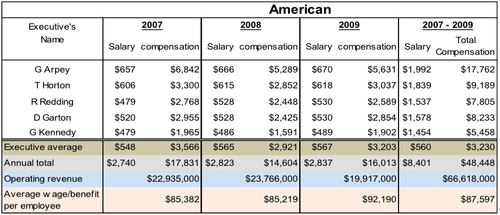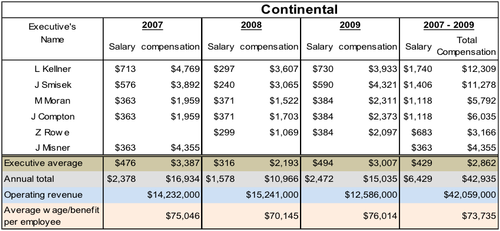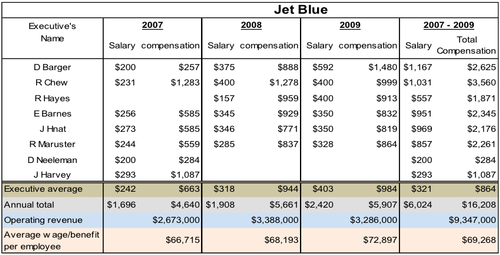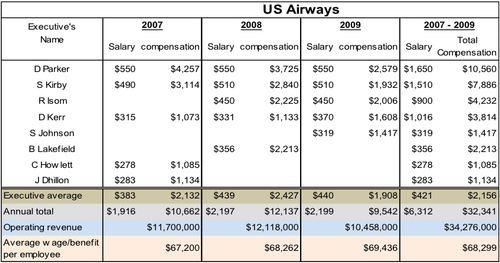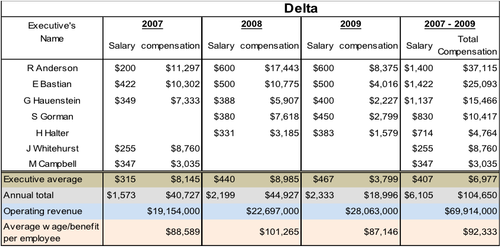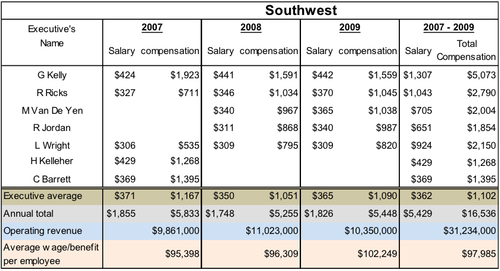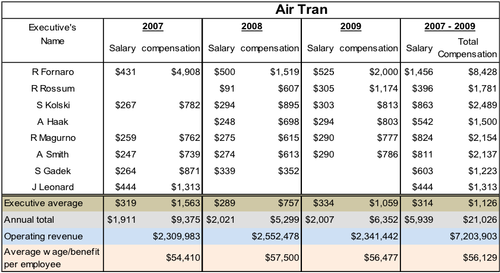US airline employee incentive plans largely window dressing
An interesting thing happened with the last few quarterly conference calls. Executives began reporting how much money employees received in incentive payments for meeting performance goals related to the Department of Transportation's consumer metrics. And the numbers reported seemed impressive, until you compare them with executive compensation. The employee performance packages may sound good, but are largely window dressing as union complaints about executive payouts rise. The Centre for Asia Pacific Aviation's America Airline Daily analysed the wage and benefit gap with the help of Bob Herbst who heads up AirlineFinancials.com.
AirTran had the lowest estimated average wage/benefit package per employee at USD56,000, but as a ratio of total employee compensation, executive payouts were the largest. Alaska took the top position as executive pay as a percentage of operating revenue. Meanwhile, Southwest had the highest average wage/benefit per employee at over USD102,000. Executive compensation at Delta well outpaced the executive compensation at its peers, but average employee wage/benefit were pretty standard at USD90,000s, although United came in far cheaper at USD76,200, almost dead on that of Continental at USD76,000. US Airways' average wage benefit per employee was the least of all the legacies at USD69,400.
A simple plan
"This round of incentive pay has some of its roots in the bankruptcy negotiations," explained MIT International Center for Air Transportation Research Engineer William Swelbar.
"The attempt was to begin the long process designed to better align stakeholder interests. I do not think it does a thing to ameliorate the need for concessions in productivity. Because that is what it is about - an industry still carrying more headcount than the work requires. Unlike the most recent restructuring negotiations that absolutely sought lower salary and benefit costs, in this round of negotiations, you hear more about cost-neutral negotiations. In cost neutral, the message is more 'that I will increase your W2 earnings in concert with the efficiencies gained in the collective bargaining agreement.' Not a perfect gain sharing definition, but close. At the end of the day, labour needs to put at risk more of their overall compensation. Not only does this begin a process of addressing the industry's troubling boom and bust cycles of earnings but it also begins to align the interests of labour with other stakeholders like management and capital".
Alaska
Chief Financial Officer and Executive Vice President, Finance Glenn Johnson explained the incentive programs were relatively new and designed to "create a virtuous cycle" of employee participation in achieving goals and profiting from their work. "Alignment of employees and our goals is critical," he told analysts in the company's 4Q2009 conference call. "Frankly, disenfranchised employees have been a problem in our industry for a long time. Our job is to get value out of the investment we make in making these programs work."
The company paid out USD76 million in incentive pay to Horizon Air and Alaska Airlines employees in 2009 as part of the Performance Based Pay (PBP) which was launched in 2005. This included incentives for excellent on-time performance, a high level of customer satisfaction, and profitability.
Performance-Based Program (PBP), Johnson explained, is based on goals set by the board in the fall and is designed to align employee actions on safety, customer satisfaction and unit costs. Each of these factors is weighted at 10%. Achieving goals toward profitability is weighted at 70%. "If we achieve our targets the majority of employees earn an incentive bonus of 5% of pay," he said. "If we exceed the goals, employees have an opportunity to earn up to maximum 10% of pay. And, if we miss our goals, there is no payout. At target, our PBP would pay USD35 million per year compared to the USD58 million paid this year which correlates to about 8% of pay since we were between the target and the max levels set by the board."
Johnson also said there is a monthly program called the Operational Rewards Program, in which every employee participates which allows a payout of up to USD50 per month when they achieve customer satisfaction and USD50 per month for on-time goals. "In 2010, we are budgeting for the PBP and the traditional profit sharing we are pledging incentive pay at USD50 million compared to USD76 million in 2009 when we exceeded goals," he said. "That represents a USD25 million reduction from 2009. Recognize this year is higher than expected, and at 10% ROIC income level, if we were paying at target that represents 15% of profits, which we believe is a good investment to ensure alignment."
Meanwhile, the top five executives at the airline received a total USD1.5 million in salary and USD11.4 million in total compensation. CEO Bill Ayer, alone, earned USD374,000 in salary and total compensation of USD4.5 million, while the average employee wage and benefit package was USD91,500 compared to the executive average of USD2.2 million. Alaska posted a USD89 million net profit (ex special items) on operating revenue of USD3.3 million in 2009.
American
American Airlines paid out USD45 million to 70,000 frontline employees in 2009 under its performance program which paid its first employee performance bonuses in 2004. Since its inception USD106 million have been paid to employees, USD10.3 million in 4Q2009 alone. The Customer Experience Rewards payout is part of the company's Annual Incentive Plan (AIP), which rewards employees with up to USD100 per month for exceeding goals in the areas of customer satisfaction and on-time performance. The Customer Experience Reward goals were based on the average performance of 2007 and 2008 for on-time departures and customer satisfaction at the airport, onboard the aircraft, as well as whether customers are likely to recommend American Airlines to others, according to the airline. When American employees exceed these monthly goals, they are rewarded with a Customer Experience payout.
Meanwhile, as the average wage and benefit package per employee hovered at USD92,100 compared to the average executive package of USD3.2 million. The top five executives received USD2.8 million in salary and total compensation of USD16 million. Chair and CEO Gerard Arpey was paid USD670,000 in salary and USD5.6 million in total compensation. He did not receive a bonus but he, too, is eligible for incentive pay which was USD583. The company posted a loss in 2009 of USD1.3 billion (ex special items) on USD19.9 billion in operating revenues.
American's unions were incensed, and echoed similar sentiments from employees at other legacies. "Continuing their pattern of corporate excess, top executives at American Airlines have once again rewarded themselves millions in bonuses one day after reporting a wider than expected earnings loss," said Association of Professional Flight Attendants president Laura Glading, joining a chorus that included the Allied Pilots Association and the Transport Workers Union. "At the same time Flight Attendants and other frontline employees continue to make sacrifices - nearly USD11 billion since 2003 - and struggle to make ends meet while being asked to take more concessions in contract negotiations. It's time to stop the corporate greed that has brought down the hard-working middle class of our country."
But the company defended the executive pay. "Our management compensation targets the median of the market, and it strongly links to pay to performance and the interests of shareholders," Investor Spokesperson Andy Backover explained. "There is no better example of what we mean by at-risk pay than the 2007 stock compensation that vested this week. All of the management participants combined - approximately 1,000 people -- received roughly $3 million in total value from the 2007 stock grants that just vested - giving stock recipients less than 7 cents on the dollar compared what the company intended to pay them three years ago. It's hard to envision how that outcome could be characterized as excessive."
Continental
Continental paid out USD25 million in performance incentives for 2009, up from USD20 million (USD455 per employee) in 2008. However, that was quite a swing from the USD191 million in cash incentives paid out in 2007. The 2007 awards include USD158 million of profit sharing and USD33 million, or USD755 per employee in on-time incentive payments which was introduced in 1996.
Larry Kellner was paid USD730,300 in salary up from USD296,800 in 2008. But he was also paid USD2.4 million in incentive payments, up from USD1.9 million. His total 2009 compensation package was USD3.9 million. Smizek, who has pledged to forego his 2010 salary if the company does not post a profit this year, was paid USD590,000 in 2009 and a total compensation of USD4.3 million as the average employee compensation in wages and benefits was USD76,000. The company lost USD295 million (ex special items) in 2009 on USD12.5 billion in operating revenue.
JetBlue
The JetBlue program combines periodic cash payouts with retirement earnings. "We guarantee every eligible JetBlue crewmember an annual company contribution equivalent to 5% of his or her eligible salary be paid into a tax-deferred account and pay any excess over 5% in cash when our profit sharing formula of 15% of pre-tax earnings produces more than 5% of each crewmember's eligible salary," explained JetBlue Communications Manager Mateo Lleras. "Also, the profit sharing plan only applies to non-managers and below (for managers and above, we have the stock incentive plan), and for everyone, we offer the 401k match and Crewmember Stock Purchase Program (all referenced in the 10K). In 2007, we amended the profit sharing retirement plan to provide for Company contributions, subject to Board of Director approval, to be 5% of eligible non-management employee compensation or 15% of pre-tax earnings, whichever is greater," said "These contributions vest 100% after three years of service measured from an employees hire date. Our contributions expensed for the Plan in 2009, 2008 and 2007 were USD48 million, USD43 million and USD39 million, respectively."
CEO David Barger earned USD592,000 in 2009 and total compensation of USD1.48 million. The top eight executives took away USD2.4 million in salary and a USD5.9 million in total compensation at a time when the carrier made USD58 million (ex special items) on USD3.2 billion in operating revenue. The average salary and benefits for a JetBlue employee is USD72,897 compared to the executive package of USD984 million.
US Airways
US Airways, which measures employee performance with on-time performance, baggage handling and customer complaints, said it paid each employee USD350 each to its approximately 31,000 employees in 2009 for hitting performance goals in 2009 for a total of USD10.8 million. Finally, Delta paid out USD65 million to employees in 2009 as part of its Shared Rewards for achieving operational performance goals.
Chair and CEO Doug Parker earned USD550,000 and total compensation of USD2.5 million in 2009 including USD429,000 in incentive pay. In 2008, his total compensation was USD3.7 million and in 2007 it was USD4.2 million. The top eight execs took home USD2.1 million in salaries and USD9.5 million in total compensation. The average wage and benefit package per employee is USD69.4 compared to USD1.9 million for the executives. The company lost USD499 million (ex special items) in 2009 on operating revenues of USD10.4 billion.
Delta
Delta paid more than USD65 million in 2009 in employee Shared Rewards for achieving operational performance goals, according to a company spokesperson. But Delta's executive package leads the industry in terms of executive compensation.
Richard Anderson received USD600,000 in salary and USD8.4 million in total compensation, albeit a 53% drop from 2008. The top seven executives earned USD2.3 million in salary and USD18.9 million in total compensation. Meanwhile, the average employee wages and benefit totaled USD87,146, compared to USD3.7 million average for Delta executives. The company took a USD1 billion loss (ex special items) in 2009 on USD28 billion in operating revenues.
The rest of the pack
United, AirTran, and Southwest did not respond to queries about employee incentive packages. However, the gap between management and the average employee is readily apparent in the AirlineFinancials.com statistics.
United's top eight execs took home USD3.3 million in salaries and USD10.7 million in total compensation. The average employee wage/benefit package was USD76,261 compared to USD2.1 million for United executives. Tilton was paid USD850,000 in salary and a total package of USD3.8 million. The company lost USD1.1 billion (ex special items) on operating revenues of USD16.3 billion.
Southwest's executives earned USD1.8 million in salary and USD5.4 million in total compensation. Here again, the lone female executive, Laura Wright, was not paid as much as her male counterparts, although United CFO Kathryn Mikells seems to be holding her own, compared to her United peers. Gary Kelly was paid USD442,000 in salary and USD1.5 million in total compensation. Meanwhile, the average employee wage/benefit package topped the industry at USD102,249 compared to USD1 million for the average Southwest executive. Southwest posted USD143 million (ex special items) in profits in 2009.
AirTran's Bob Fornaro received USD525,000 in salary and USD2 million in total compensation while the top eight execs took home USD2 million in salary and USD6.3 million in total compensation. AirTran had the lowest average employee wage/benefit package at USD56,477 versus the average executive package of USD1 million. AirTran posted USD94 million in net profits last year on operating revenues of USD2.3 billion.

